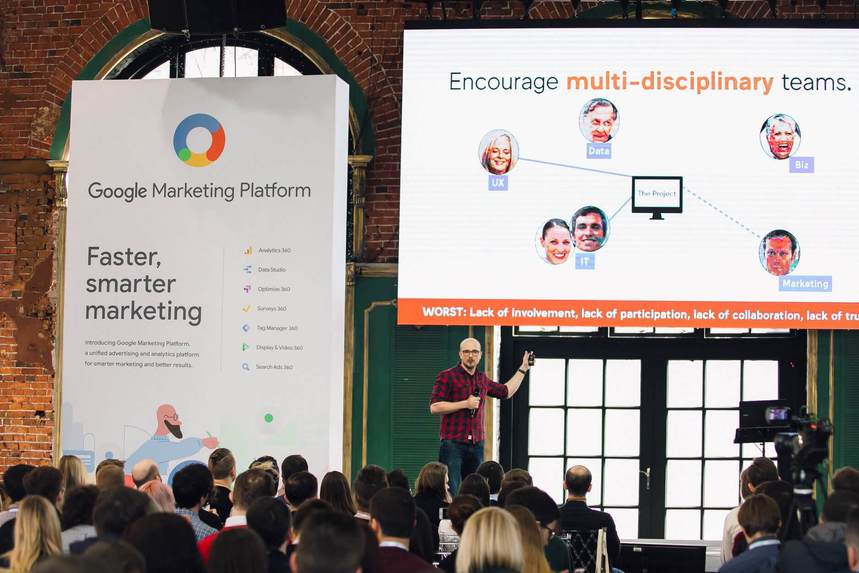OWOX BI Research on the State of Digital Analytics: Interview with Simo Ahava
Mariia Bocheva, Business Development Executive @ OWOX
Olha Diachuk, Creative Writer @ OWOX
We had a great chance to interview Simo Ahava after his inspiring talk at the Go Analytics! conference as part of our research on the state of digital analytics in 2019.

Simo Ahava is a talented analyst and a co-founder of 8-bit-sheep, a consulting company that specializes in creating healthy communication structures. So he’s quite familiar with how to cultivate efficient analytics.We discussed a number of questions any marketer or analyst will find interesting. They’re broken down into the following categories:
All questions were prepared and asked by Mariia Bocheva, our Business Development Executive (who likes to quote Simo’s blog aloud during our daily meetings). :)
Challenges we all face
What difficulties do you see when it comes to implementing analytics and how would you assess the overall development of the market?
I guess the main difficulty is understanding the possibilities and limitations of each tool. There’s a degree of black-box-ness to every single tool on the market. I don’t mean that these tools hide how they work (though some do, deliberately), but rather that the integration of these tools into the organization’s processes can be very unpredictable.
I’m also concerned about how so many new services strive to make things “faster.” As if speed is inherently some virtue that all companies must follow. Being fast often comes at the cost of being careful, and there’s always a risk of doing something really fast only to produce results that can be very misleading.
I do think that the overall knowledge and understanding of technical stacks has improved, because tools like tag management solutions demystify the developer world. That’s great – it’s a trend I hope will continue in the future. Similarly, cloud services are becoming more accessible and affordable, which has led to an increased interest in automation and data engineering.
How can an analyst have a greater impact on marketing?
How can they be useful for the marketing team?
An analyst doesn’t have to have an impact on marketing. Data does. An “analyst” is just a description of a role, and I personally consider it almost harmful to have someone labelled as an “analyst” be a strong force in the organization. As soon as you hire an analyst, you have found someone to delegate all that “data stuff” to.
The role of the analyst should be more in organization coaching. They should inspire the marketing and development teams to think beyond their own capabilities and consider data as an integral part of their own work.

Because an analyst works with data, their role should transcend different teams, and they should function as a bridge between different parts of the organization. In that way, they are more akin to Scrum masters and product owners than to individual data crunchers.
What analytical challenges do you have right now?
I don’t face any analytical challenges per se, but it’s a constant challenge to understand the tools I work with and how those tools can be best used to help organizations make more sense of their data.
At the same time, I’m also challenged by how to make organizations more aware of their own shortcomings. The biggest challenge to analytics, or really any digital discipline, is how to integrate it into the organization’s processes without hyperbole or exaggeration. Many companies strive to be “data-driven” or “digital first,” which very quickly turns into a hunt for the best tool out there, when in fact these organizations should focus on building multi-disciplinary teams, more agile approaches to service design, and an increased understanding of what business questions and problems need to be solved before figuring out what tool does all that.


Hard communication issues

Do you think miscommunication between analysts and marketing teams is common? If yes, do you have any recommendations on how to overcome it?
It’s just as common as miscommunication between any two people in an organization. How to solve miscommunication? By communicating better :)
There’s a lot to learn from agile methodologies such as Scrum, which are entirely dependent on robust communication structures in the organization. If you find that there are communication problems, it’s absolutely necessary to find out why they exist and to solve them by introducing new settings and contexts for communication, such as daily meetings, backlog grooming, retrospective sessions, and demos.
Communication problems create rusty pipelines and rot the data flow within an organization. It’s absolutely imperative to fix those.

What knowledge are analysts and marketing specialists missing in order to make companies data-driven?
I think they are mostly missing two things:
- They think a company should be data-driven
- Buy-in and trust from the people around them
It’s difficult to push for change if you use terminology such as “data-driven.” A company is driven by a mixture of data, intuition, expertise, people resources, etc. There’s no one thing that drives the change.
The other reason it’s difficult to find a foothold in a company is because there’s a lack of trust in what you do. This is a communication problem. So see my response to the previous question :)
Buy-in and trust can be acquired by making your efforts transparent – add big dashboards all around the office, make data the focus of discussion in demos and in sprint meetings, make everyone aware that every little thing that’s done to the product or service has a measurable impact.
To go deeper into Simo Ahava’s thoughts on communication issues, download his presentation to read it while listening to his live performance for Go Analytics! Conference.
Future trends in marketing analytics

What do you think is the future of marketing analytics?
What trends do you see coming and what’s in high demand?
I think the future is murky. Restrictions in the browser and app space (Safari’s suppression of first-party cookies, ad and content blocking, etc.), increased demand for privacy-driven design, and the unreliability of signal data in the long run are all making it difficult to peer into the future.
I’m certain marketing analytics will continue to shift away from single-vendor approaches (e.g. Google Analytics) to a more holistic data pipeline, meaning data engineers are going to be ever more in demand.
What opportunities do you see on the market today?
There are vendors, organizations, individuals, countries, politicians, legislators, and human beings in general doing silly things. All of these contribute to uncertainty in digital disciplines, marketing included. We can either accept that at face value, and continue to struggle in an increasingly more limited space, or we can break through the silos and start thinking of marketing analytics not as a single discipline but as a broader spectrum of possibilities that a company can realize with data.
Marketing is tightly coupled with product and service design. If an organization has a dedicated marketing team that is not involved in the day-to-day mechanisms of what the company actually produces, then that’s a problem. Similarly, if organizations still believe that finding the best tool is the solution to all their problems, then that’s a problem.
Personally, I think the biggest problem is one that’s never really gone away: failure to communicate. Every single hiccup an organization might face, from the smallest bug to the biggest PR disaster, can always be traced back to a communication problem between two or more individuals. Fixing these communication issues is the key to fixing the organizations, and fixing the organizations is the key to a healthier market.
Analysts’ skills and biggest mistakes

What hard skills are most important for analysts today? Does an analyst have to know SQL, Python, and R and build dashboards in the most common visualization tools, like Data Studio, Tableau, QlikView, etc?
I think the baseline for analytics is still very much dependent on what type of analytics you want to do. The problem of setting an expectation for skills is that it creates exclusivity rather than invites people to start working with the discipline. There’s a fair lot you can do when you enter the analytics space and you have no experience with programming languages or external visualization tools. Once you progress, however, the requirements become more specific.
- For web analytics, an understanding of the browser stack is paramount.
- For anyone working with large datasets, SQL is a must.
- Python vs. R is an evergreen discussion, but I don’t think either is necessary if you want to work in analytics.
But if I were forced to choose, I would choose Python thanks to its extensibility beyond the realm of data analytics alone.
What soft skills should a good analyst have?
Empathy for the business environment they work in, quick reflexes to adapt to the changes around them, a bridge-building mentality to work across silos rather than reinforce them, and an insatiable thirst to learn new things.
The most important skill is communication. Data is one of those things that really suffers if the people in the organization where that data is produced fail to communicate. Data is the blueprint of the organization, and it can reveal flaws in the organization more honestly than any consultant ever could.
What’s the biggest mistake an analyst can make?
Can you share some of your analytical mistakes?
The biggest mistake anyone working with data can make, in my opinion, is deliberately misinterpreting or misusing metrics to support a failed hypothesis. I see this often in low-maturity organizations that are getting started with A/B testing or have just implemented Google Analytics. They configure conversions to support «self-evident» hypotheses, and deliberately avoid accepting test results that go against the grain of what they intuitively think is right.
The same vein of thinking can be seen in using something as simple as bounce rate to describe engagement on a site, for example. Without extensive customization and without a consistent implementation strategy to map all those engagement activities into bounce-killing events, the bounce rate is a superficial, shallow metric that can lead to incorrect conclusions more often than not.
My own mistakes as a consultant often have to do with the two things I described above. It’s easy for me to get swept by the «ease» of analytics in cases where I need to be able to produce good results quickly. It’s something I try to avoid the best I can, but being totally impartial to data is often very difficult. I find it easier to be fair in cases where I’m not emotionally too invested in the client’s business — in those cases it’s easier to be brutally honest and to try to persuade the organization to turn around their way of thinking.
OWOX BI bottom line
We really appreciate all of Simo’s answers and are ready to sign under his every word. Over the last 20 years, the currents in the ocean of data have started moving faster, even crushing some boats. It’s important to dive into your data equipped with the proper tools, but what’s more important is having a truly devoted team aboard.
We totally agree with Simo. Every day, we’re providing our services to enable CMOs, marketers, and analysts to achieve a new level of data analytics in their companies by simplifying the collection, alignment, reporting, and visualization of data.
So let’s keep in touch! Subscribe to our blog to read the next interviews from our research on the state of digital analytics and adapt the experience of top analysts to your business.
What would you ask Simo about? Let us know in the comments below!












